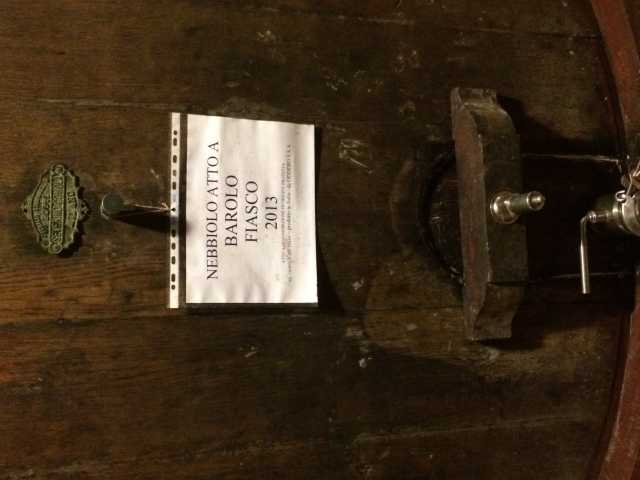My first visit to G.D. Vajra in 2011 was kind of a revelation – the quality was so strong across the board – so I was eager to return. (Here’s my posting on that visit.) I was not disappointed. This time Melina Vaira poured and generally exuded charm.
2015 Langhe Riesling: From vines in the Fossati cru and in Sinio, just outside the Barolo DOC near Serralunga. I’ve liked every vintage of this wine that I’ve had since I first stumbled on it maybe eight years ago. The 2015 was true to form. There’s a trace of reduction on the nose along with white peach aromas. In the mouth I got that peach with a good spine of acidity. This resembles a German Trocken versus the more Austrian/Alsatian (or Grosse Gewachs) style that Germano makes (see above). I like both, but I lean toward this leaner interpretation of the grape. Melina said she feels it should be aged for 10 years but realizes that few bottles are. A 2012 I stumbled on in Massachusetts this summer was very pleasing. Now I want to lay away a few bottles.
2013 Barbera d’Alba Superiore: The warm vintages always seems to pay off with barbera, and this had oodles of ripe black cherries for me, plus an earthiness that the best barberas offer (think G. Conterno). Lots of acid but there was so much fruit here that the acid didn’t dominate, as it can too often with barbera. First rate. Howard Davis was told this is from vines that are 35+ years old and that it’s macerated around 30 days. I just ordered some here in New York.
2014 Langhe Nebbiolo: From young Barolo vines plus fruit from the Cascina Bertone vineyard in Sinio near Serralunga (Ken Vastola posted a map). The fermentation is 15-20 days and it’s aged all in steel. Notwithstanding the challenges of the vintage, this turned out well, and I guess I’ll have to question my view above that nebbiolo needs some time wood. This is less ripe than the ’09 and ’11 versions, which I own, and not on a par with the ’11, which punched well above its weight. But it’s still good.
2012 Barolo “Albe”: This is the base bottling at a good price (as low as $30 in the U.S.). The name means sunrises is the local dialect, and I believe Melina said it refers to easterly exposure of the three sites from which the fruit comes. The 2012 shows a lot of fruit on the nose and is rich on the palette. It’s actually riper than the ’12 Barolo crus but lacks a little concentration and structure and is less complex. Still, a step up from most Nebbiolo Langhe/d’Alba and not that much more expensive.
2012 Barolo Bricco delle Viole: Vajra’s signature wine, from the vineyard surrounding the cantina, near the upper elevations of the Barolo commune (~400 meters). I found this exceptional. Intense floral notes on the nose (the vineyard name means ridge of the violets) and dried strawberry and other lighter red fruits – definitely toward the feminine side of Barolo. Think Chambolle-Musigny. Same thing in the mouth: elegant, red fruits but with good structure to match. I was sold at the first sniff, but it delivered in the mid-palate and the finish and I kept returning to this glass in the line-up. I gave it 92 at the time. Ken Vastole gave it 94. Howard Davis was not so keen, saying it wasn’t a strong example of BdV. Greg dal Piaz gave this 91 – one of his higher scores for a 2012.
2012 Barolo Ravera: Deeper, more dark-fruited on the nose, and also less open than the BdV. Same story in the mouth – tougher, more tannic, more masculine, less fruity. More tightly wound at this point. Hard for me to put a score on this. Howard had the opposite experience, finding it more open. It may be a matter of time and air. Barolo can be a furtive beast at this stage in its life. Greg was a little less keen, giving it 90.
2012 Luigi Baudana - Barolo Baudana cru: From the small estate in Serralunga that Vajra purchased in 2008. If the Bricco delle Viole is Chambolle, this is Gevrey-Chambertin – beefier, more masculine and spicy. I liked this as much or more than the BdV. I got a floral profile on the nose that was similar to the BdV, and it was quite elegant in the mouth. “Really outstanding,” I wrote and gave it 93. Ken was similarly enthusiastic (92). Howard found it “a lesser Barolo than the two Vajra Baroli.” Greg also scored it lower than the wines under the Vajra name: 88 points.
2012 Langhe Freisa “Kyè”: It’s probably unfair to judge this wine now. It is darker in color than the Barolos, with an intense, almost cherry/plum liqueur-like bouquet. In the mouth, it was coarser than the Barolos, as you’d expect from freisa, but it’s balanced. Having drunk the ‘89 and ‘90 of this wine seven or eight years ago, I’d guess this has a lovely, more complex future ahead of it. After 18 years or so, those Kyes had converged with Barolo.
(Edited to add link to 2011 thread.)
